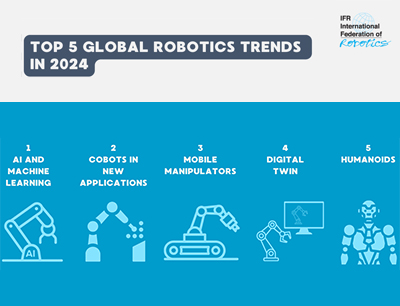
The global stock of industrial robots has reached a new record of around 3.9 million units. The strong demand is being driven by a number of exciting technological developments. The International Federation of Robotics has summarised the most important trends that will shape robotics and automation in 2024. “The five mutually reinforcing automation trends in 2024 show that robotics is a multidisciplinary field where technologies are converging to create intelligent solutions for a wide range of tasks,” says Marina Bill, President of the International Federation of Robotics. “These advances continue to shape the merging industrial and service robotics sectors and the future of work.”
The use of artificial intelligence in robotics and automation continues to grow. The development of generative AI is opening up new solutions. This subgroup of AI specialises in learning through training and creating something new from it - these solutions have already become popular with online tools such as ChatGPT. Robot manufacturers are developing generative AI-controlled interfaces to enable robots to be programmed more intuitively: Users programme with natural language instead of code. They no longer need special programming skills to select and customise the desired actions of the robot. Another example is predictive AI, which analyses robot performance data to determine the future condition of systems. Predictive maintenance can save manufacturers money on machine downtime. In the automotive supply industry, every hour of unplanned downtime costs an estimated 1.3 million dollars.
Human-robot collaboration continues to be an important trend in robotics. Rapid advances in the development of sensors, image processing technologies and intelligent grippers enable robots to react to changes in their environment in real time and thus work safely alongside humans. Collaborative robot applications support humans in their daily work: tasks such as heavy lifting, repetitive movements or working in hazardous environments are no longer necessary.
Robot manufacturers are offering more and more areas of application for collaborative applications. One current market development is the increase in robot welding applications, triggered by the shortage of skilled labour in this segment. This demand shows that automation does not lead to a shortage of labour, but rather contributes to solving the labour shortage. In this respect, collaborative robots will complement - not replace - investments in traditional industrial robots that work at much higher speeds. Traditional industrial robotics will remain important to improve productivity in response to tight product margins. In addition, new competitors are entering the market, focussing specifically on collaborative robots. Mobile manipulators, a combination of collaborative robotic arms and mobile robots (AMR), offer new application possibilities that could significantly increase the demand for collaborative robots.
Mobile manipulators - known as "MoMas" - automate material handling in sectors such as the automotive industry, logistics and aerospace. They combine the mobility of robot platforms with the dexterity of manipulator arms. This enables them to move and handle objects in complex environments. This capability is particularly important for applications in production. Equipped with sensors and cameras, they carry out inspection and maintenance work on machines and systems. A key advantage of mobile manipulators is that these machines can work directly with human workers. The shortage of skilled labour in the industry is likely to further increase demand in the future.
Digital twins are increasingly being used to improve the performance of physical systems. Virtual images of these systems are used. As robots in factories become increasingly digitally integrated, digital twins can utilise the captured real-world operational data to perform simulations and predict likely outcomes. As a pure computer model, the twin can be tested and modified under stress conditions without causing wear and tear or safety risks. Compared to tests on physical systems, such virtual simulations save considerable costs. The advantage: digital twins close the gap between the digital and physical world.
In the field of robotics, significant technological advances have been made in the development of humanoids that can perform a wide range of tasks in different work areas. The human-like design with two arms and two legs allows the robot to be used flexibly in working environments that were actually created for humans. For example, it can be easily integrated into existing warehouse processes and infrastructures.
The Chinese Ministry of Industry and Information Technology (MIIT) recently published detailed targets on how the country intends to mass-produce humanoids by 2025. The MIIT believes that humanoids will be another disruptive technology, similar to computers or smartphones, that could change the way we produce goods and the way we live. Humanoids are an exciting area of development due to their potential impact on various sectors. However, introducing humanoids to the mass market remains a complex challenge. A key factor is cost: success will depend on whether they are viable in competition with established robotic solutions such as mobile manipulators.